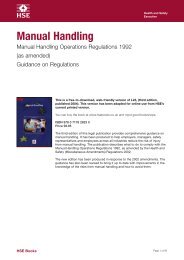Making Companies Safe - what works? (CCA ... - Unite the Union
Making Companies Safe - what works? (CCA ... - Unite the Union
Making Companies Safe - what works? (CCA ... - Unite the Union
Create successful ePaper yourself
Turn your PDF publications into a flip-book with our unique Google optimized e-Paper software.
A similar experiment in self-regulation, but one that applied only to firms with exemplary<br />
safety records within <strong>the</strong> construction industry, was California’s Cooperative Compliance<br />
Program (CPP). The program focused on seven large construction projects, each employing<br />
between 250 and 4500 workers. Participating companies agreed to establish joint<br />
labour-management safety committees that would carry out many of OSHA’s regulatory<br />
functions, whilst routine OHSA inspections were discontinued. 18 A ra<strong>the</strong>r different sort of<br />
initiative was <strong>the</strong> “Maine 200” program, which differs from VPP and CPP in that it was aimed<br />
at <strong>the</strong> 200 companies with <strong>the</strong> state’s highest levels of injuries. Participating companies<br />
worked cooperatively with OHSA to develop health and safety programs to identify and abate<br />
hazards and self-report identified hazards to OHSA. In return, firms were not prosecuted for<br />
any safety hazards or violations that came to light during <strong>the</strong> process, and were only<br />
subject to traditional inspection and citation in response to worker complaints, accidents and<br />
referrals. 19<br />
It is important to note that even though OSHA introduced its first Voluntary Protection<br />
Programs (VPP) over twenty years ago, a report by <strong>the</strong> US General Accounting Office (GAO)<br />
published this year concluded that <strong>the</strong>re had never been a systematic evaluation of ei<strong>the</strong>r <strong>the</strong>ir<br />
individual or <strong>the</strong>ir relative effectiveness. 20 The evidence that does exist in relation to <strong>the</strong><br />
impact of <strong>the</strong>se programmes is contradictory.<br />
Participating firms and OSHA have claimed that VPP companies are achieving significant<br />
reductions in <strong>the</strong>ir injury rates. 21 And a report by <strong>the</strong> OECD refers to ‘evidence’ that firms<br />
participating in <strong>the</strong> Maine 200 Program in <strong>the</strong> <strong>Unite</strong>d States achieved an overall reduction in<br />
compensation claims of 47.3% between 1991 and 1994 (as compared to a reduction of 27%<br />
amongst all Maine employers). 22 However, an analysis of <strong>the</strong> Maine 200 program<br />
commissioned by OSHA paints a more complicated picture. While OSHA reported that by<br />
1995 employers had identified and reported hazards at a rate 14 times greater than would<br />
have occurred under traditional OSHA enforcement, Mendeloff makes three observations<br />
which cast doubt on <strong>the</strong> significance of <strong>the</strong>se results. 23 First, half of <strong>the</strong> identified hazards<br />
came from four particular firms in <strong>the</strong> paper industry, all of which were unionised. Therefore<br />
<strong>the</strong> impressive level of hazard identification may not have been representative and may have<br />
been a consequence of strong trade union organisation and action on health and safety.<br />
Second, <strong>the</strong>re was little information about <strong>the</strong> severity of <strong>the</strong> hazards identified in <strong>the</strong><br />
companies’ self-surveys, so it was difficult to assess how <strong>the</strong>y compared to <strong>the</strong> type of<br />
problems detected through traditional enforcement. And finally, whilst <strong>the</strong> companies<br />
claimed to have corrected around 68 per cent of <strong>the</strong> hazards identified, OSHA had no means<br />
of verifying this claim since all information on hazard identification and abatement came from<br />
<strong>the</strong> companies <strong>the</strong>mselves. 24<br />
In relation to assertions that companies participating in OSHA’s VPP, CCP and Maine 200<br />
programs achieved impressive reductions in reported injury and illness rates, Needleman<br />
notes that:<br />
“<strong>the</strong> decline in workers compensation claims that accompanied <strong>the</strong> Maine 200<br />
program can be explained in many different ways, some of <strong>the</strong>m inconsistent<br />
with worker safety.” 25<br />
In particular, <strong>the</strong>re is evidence that reductions in workers compensation claims associated with<br />
VPP, CPP and Maine 200 may have been achieved through <strong>the</strong> internal suppression of<br />
reporting, and by placing workers on ‘light duties’, ra<strong>the</strong>r than through genuine reductions in<br />
lost time injuries and ill-health. 26 The AFL-CIO reports that many of <strong>the</strong> firms achieving VPP<br />
status have instituted internal systems whereby workers receive rewards or prizes when <strong>the</strong>y<br />
do not report injuries and/or are threatened with and receive punishment if <strong>the</strong>y do report<br />
injuries.<br />
An example of this is <strong>the</strong> “Accident Repeaters” program, which is based on <strong>the</strong> assumption<br />
that occupational injuries result from <strong>the</strong> unsafe acts of individual workers ra<strong>the</strong>r than from<br />
unsafe work environments. Any worker who reports two injuries in a period of two years will<br />
be placed on <strong>the</strong> Accident Repeaters program. The next injury <strong>the</strong>y report is followed by<br />
counselling on how to be a safe worker or perhaps by compulsory attendance on a safety<br />
awareness-training program. Any injuries that are reported after this may be followed by a<br />
85
















